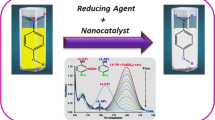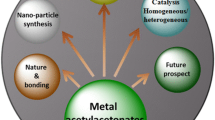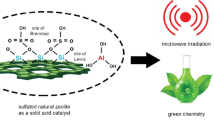Abstract
In order to further improve the catalytic activity and stability of heterogeneous acid catalysts, a polystyrene microspheres modified sulfonic acid-based catalyst (PS-SO3H) was prepared. PS-SO3H was characterized by Fourier transform infrared spectroscopy, powder X-ray diffraction, scanning electron microscope, transmission electron microscope, N2 adsorption–desorption, and X-ray photoelectron spectroscopy. Catalytic efficiency was determined using the reaction of furfuryl alcoholysis to ethyl levulinate (EL). The obtained results showed that PS-SO3H had excellent catalytic performance, with EL yield of 94.7%. In addition, PS-SO3H was easily separated from the reaction system and recycled multiple times without significant reduction in activity. High catalytic activity stemmed from the effect of Brønsted acid sites and appropriate structural properties.
Graphical Abstract











Similar content being viewed by others
References
He SB, Bijl A, Rohrbach L et al (2021) Catalytic upcycling paper sludge for the recovery of minerals and production of renewable high-grade biofuels and bio-based chemicals. Chem Eng J 420:129714
Gallezot P (2012) Conversion of biomass to selected chemical products. Chem Soc Rev 41(4):1538–1558
Alonso DM, Bond JQ, Dumesic JA (2010) Catalytic conversion of biomass to biofuels. Green Chem 12(9):1493–1513
Chang J, Leung DYC, Wu CZ et al (2003) A review on the energy production, consumption, and prospect of renewable energy in China. Renew Sust Energ Rev 7(5):453–468
Liu CW, Zhang CH, Liu KK et al (2015) Aqueous-phase hydrogenolysis of glucose to value-added chemicals and biofuels: a comparative study of active metals. Biomass Bioenergy 72:189–199
Gupta P, Paul S (2014) Solid acids: green alternatives for acid catalysis. Catal Today 236:153–170
Piscopo CG (2015) Supported sulfonic acids: solid catalysts for batch and continuous-flow synthetic processes. ChemistryOpen 4(3):383–388
Gawande MB, Hosseinpour R, Luque R (2014) Silica sulfuric acid and related solid-supported catalysts as versatile materials for greener organic synthesis. Curr Org Synth 11(4):526–544
Demolis A, Essayem N, Rataboul F (2014) Synthesis and applications of alkyl levulinates. Acs Sustain Chem Eng 2(6):1338–1352
Wang MM, Peng LC, Gao XY et al (2020) Efficient one-pot synthesis of alkyl levulinate from xylose with an integrated dehydration/transfer-hydrogenation/alcoholysis process. Sustain Energy Fuels 4(3):1383–1395
Vaishnavi BJ, Sujith S, Kulal N et al (2021) Utilization of renewable resources: investigation on role of active sites in zeolite catalyst for transformation of furfuryl alcohol into alkyl levulinate. Mol Catal 502:111361
Chada RR, Koppadi KS, Enumula SS et al (2018) Continuous synthesis of fuel additives alkyl levulinates via alcoholysis of furfuryl alcohol over silica supported metal oxides. Catal Lett 148(6):1731–1738
Martin NH, Allen NW, Brown JD et al (2003) An NMR shielding model for protons above the plane of a carbonyl group. J Mol Graph 22(2):127–131
Przypis M, Matuszek K, Chrobok A et al (2020) Inexpensive and tuneable protic ionic liquids based on sulfuric acid for the biphasic synthesis of alkyl levulinates. J Mol Liq 308:113166
Brzeczek-Szafran A, Wieclawik J, Barteczko N et al (2021) Protic ionic liquids from di- or triamines: even cheaper Bronsted acidic catalysts. Green Chem 23(12):4421–4429
Freitas FA, Licursi D, Lachter ER et al (2016) Heterogeneous catalysis for the ketalisation of ethyl levulinate with 1,2-dodecanediol: opening the way to a new class of bio-degradable surfactants. Catal Commun 73:84–87
Lange JP, van de Graaf WD, Haan RJ (2009) Conversion of furfuryl alcohol into ethyl levulinate using solid acid catalysts. Chemsuschem 2(5):437–441
Zhou SL, Jiang DB, Liu XX et al (2018) Titanate nanotubes-bonded organosulfonic acid as solid acid catalyst for synthesis of butyl levulinate. RSC Adv 8(7):3657–3662
Armatas GS, Bilis G, Louloudi M (2011) Highly ordered mesoporous zirconia-polyoxometalate nanocomposite materials for catalytic oxidation of alkenes. J Mater Chem 21(9):2997–3005
Kuzminska M, Kovalchuk TV, Backov R et al (2014) Immobilizing heteropolyacids on zirconia-modified silica as catalysts for oleochemistry transesterification and esterification reactions. J Catal 320:1–8
Srilatha K, Issariyakul T, Lingaiah N et al (2010) Efficient esterification and transesterification of used cooking oil using 12-tungstophosphoric acid (TPA)/Nb2O5 catalyse. Energy Fuels 24(9):4748–4755
Bringue R, Ramirez E, Iborra M et al (2019) Esterification of furfuryl alcohol to butyl levulinate over ion-exchange resins. Fuel 257:116010
Lucas N, Gurrala L, Athawale A (2019) Heteropolyacids supported on mesoporous AlSBA-15 as efficient catalysts for esterification of levulinic acid. J Porous Mater 26(5):1335–1343
Manyar HG, Chaure GS, Kumar A (2006) Supported polyperoxometallates: highly selective catalyst for oxidation of alcohols to aldehydes. J Mol Catal A-Chem 243(2):244–252
Shokrolahi A, Zali A, Pouretedal HR et al (2008) Carbon-based solid acid catalyzed highly efficient oxidations of organic compounds with hydrogen peroxide. Catal Commun 9(5):859–863
Liu XF, Li H, Zhang H et al (2016) Efficient conversion of furfuryl alcohol to ethyl levulinate with sulfonic acid-functionalized MIL-101(Cr). RSC Adv 6(93):90232–90238
Song DY, An S, Lu B et al (2015) Arylsulfonic acid functionalized hollow mesoporous carbon spheres for efficient conversion of levulinic acid or furfuryl alcohol to ethyl levulinate. Appl Catal B-Environ 179:445–457
Zhao G, Liu M, Xia XK et al (2019) Conversion of furfuryl alcohol into ethyl levulinate over glucose-derived carbon-based solid acid in ethanol. Molecules 24(10):1881
Yang JF, Zhang HY, Ao ZF et al (2019) Hydrothermal carbon enriched with sulfonic and carboxyl groups as an efficient solid acid catalyst for butanolysis of furfuryl alcohol. Catal Commun 123:109–113
Yang JF, Ao ZF, Wu H et al (2020) Waste paper-derived magnetic carbon composite: a novel eco-friendly solid acid for the synthesis of n-butyl levulinate from furfuryl alcohol. Renew Energy 146:477–483
Guo HX, Hirosaki Y, Qi XH et al (2020) Synthesis of ethyl levulinate over amino-sulfonated functional carbon materials. Renew Energy 157:951–958
Yu X, Peng LC, Pu QY et al (2020) Efficient valorization of biomass-derived furfuryl alcohol to butyl levulinate using a facile lignin-based carbonaceous acid. Res Chem Intermed 46(2):1469–1485
Sinha VR, Goyal V, Bhinge JR et al (2003) Diagnostic microspheres: an overview. Crit Rev Ther Drug Carr Syst 20(6):433–460
Wang K, Xing JF, Li XY et al (2012) Fabrication of novel magnetic nanoparticles-coated P(styrene-itaconic acid-divinylbenzene) microspheres. Carbohydr Polym 87(4):2712–2717
Wei W, Wang LY, Yuan L et al (2007) Preparation and application of novel microspheres possessing autofluorescent properties. Adv Funct Mater 17(16):3153–3158
Chang BB, Fu J, Tian YL et al (2013) Multifunctionalized ordered mesoporous carbon as an efficient and stable solid acid catalyst for biodiesel preparation. J Phys Chem C 117(12):6252–6258
Xu S, Yu JY, Sun YB et al (2015) Synthesis and characterization of organic intercalated layered double hydroxides and their application in bitumen modification. Mater Chem Phys 152:54–61
Okamura M, Takagaki A, Toda M et al (2006) Acid-catalyzed reactions on flexible polycyclic aromatic carbon in amorphous carbon. Chem Mater 18(13):3039–3045
Zhou SH, Dai FL, Xiang ZY et al (2019) Zirconium-lignosulfonate polyphenolic polymer for highly efficient hydrogen transfer of biomass-derived oxygenates under mild conditions. Appl Catal B-Environ 248:31–43
Malins K, Kampars V, Brinks J et al (2015) Synthesis of activated carbon based heterogenous acid catalyst for biodiesel preparation. Appl Catal B-Environ 176:553–558
Zhao K, Liu SF, Li KX et al (2017) Fabrication of -SO3H functionalized aromatic carbon microspheres directly from waste Camellia oleifera shells and their application on heterogeneous acid catalysis. Mol Catal 433:193–201
Ranke W (1993) UPS and XPS reference data of O, N, NO, (NO2)2, NH3, H2O, OH, H2S, SH and S on GE surfaces. J Electron Spectrosc Relat Phenom 61(2):231–240
Guo QQ, Yang F, Liu XH et al (2020) Low-cost synthesis of nanoaggregate SAPO-34 and its application in the catalytic alcoholysis of furfuryl alcohol. Chin J Catal 41(11):1772–1781
Acknowledgements
This work is supported by Major Projects in Inner Mongolia Autonomous Region (2020).
Author information
Authors and Affiliations
Corresponding authors
Additional information
Publisher's Note
Springer Nature remains neutral with regard to jurisdictional claims in published maps and institutional affiliations.
Rights and permissions
About this article
Cite this article
Hu, A., Wang, H. & Ding, J. Novel Sulfonic Acid Polystyrene Microspheres for Alcoholysis of Furfuryl Alcohol to Ethyl Levulinate. Catal Lett 152, 3158–3167 (2022). https://doi.org/10.1007/s10562-021-03881-5
Received:
Accepted:
Published:
Issue Date:
DOI: https://doi.org/10.1007/s10562-021-03881-5




